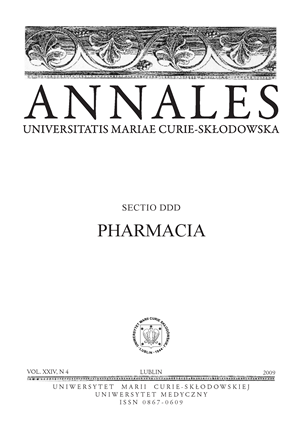Additive interaction of pregabalin with phenytoinin the mouse maximal electroshock-induced seizure model: an isobolographic analysis
Abstract
The aim of this study was to characterize the interaction between pregabalin (PGB – a thirdgeneration antiepileptic drug) and phenytoin (PHT – a classical antiepileptic drug) in the maximal electroshock (MES)-induced seizure model in mice by using the type I isobolographic analysis for non-parallel dose-response relationship curves (DRRCs). Tonic hind limb extension (seizure activity) was evoked in adult male albino Swiss mice by a current (25mA, 500V, 50Hz, 0.2s stimulus duration) delivered via auricular electrodes. In the mouse MES model, PGB administered singly had its DRRC non-parallel to that for PHT. According to type I isobolographic analysis for non-parallel DRRCs, the combination of PGB with PHT at the fixed-ratio of 1:1 exerted additive interaction. Pharmacokinetic studies revealed that PGB had no impact on total brain concentrations of PHT in experimental animals. In conclusion, the additive interaction between PGB and PHT is worthy of consideration while extrapolating the results from this preclinical study to clinical settings.
References
1. Ben-Menachem E.: Pregabalin pharmacology and its relevance to clinical practice. Epilepsia, 45 Suppl. 6, 13, 2004.
2. Borowicz K.K., Świąder M., Łuszczki J. et al.: Effect of gabapentin on the anticonvulsant activity of antiepileptic drugs against electroconvulsions in mice: an isobolographic analysis. Epilepsia, 43, 956, 2002.
3. Brodie M.J.: Pregabalin as adjunctive therapy for partial seizures. Epilepsia, 45 Suppl. 6, 19, 2004.
4. Dalby N.O., Nielsen E.B.: Comparison of the preclinical anticonvulsant profiles of tiagabine, lamotrigine, gabapentin and vigabatrin. Epilepsy Res., 28, 63, 1997.
5. French J.A., Kugler A.R., Robbins J.L. et al.: Dose-response trial of pregabalin adjunctive therapy in patients with partial seizures. Neurology, 60, 1631, 2003.
6. Kozińska J., Sawicka K.M., Zadrożniak A. et al.: Spironolactone potentiates the protective action of some selected antiepileptic drugs against maximal electroshock-induced seizures in mice. Annales UMCS, Sectio DDD, 22, 123, 2009.
7. Litchfield J. T., Wilcoxon F.: A simplified method of evaluating dose-effect experiments. J. Pharmacol. Exp. Ther., 96, 99, 1949.
8. Löscher W., Fassbender C. P., Nolting B.: The role of technical, biological and pharmacological factors in the laboratory evaluation of anticonvulsant drugs. II. Maximal electroshock seizure models. Epilepsy Res., 8, 79, 1991.
9. Łuszczki J.J., Czuczwar S.J.: Biphasic characteristic of interactions between stiripentol and carbamazepine in the mouse maximal electroshock-induced seizure model: a three-dimensional isobolographic analysis. Naunyn-Schmiedebergs Arch. Pharmacol., 374, 51, 2006.
10. Łuszczki J.J.: Interaction of oxcarbazepine with phenobarbital in the mouse pentylenetetrazoleinduced seizure model: an isobolographic analysis. Annales UMCS, Sectio DDD, 22, 61, 2009.
11. Łuszczki J.J.: Isobolographic analysis of interaction between drugs with nonparallel doseresponse relationship curves: a practical application. Naunyn-Schmiedebergs Arch. Pharmacol., 375, 105, 2007.
12. Łuszczki J. J., Antkiewicz-Michaluk L., Czuczwar S. J.: Isobolographic analysis of interactions between 1-methyl-1,2,3,4-tetrahydroisoquinoline and four conventional antiepileptic drugs in the mouse maximal electroshock-induced seizure model. Eur. J. Pharmacol., 602, 298, 2009.
13. Macdonald R. L., Greenfield L. J.: Mechanisms of action of new antiepileptic drugs. Curr. Opin. Neurol., 10, 121, 1997.
14. Tallarida R. J.: An overview of drug combination analysis with isobolograms. J. Pharmacol. Exp. Ther., 319, 1, 2006.
15. Taylor C. P., Angelot t i T., Fauman E.: Pharmacology and mechanism of action of pregabalin: the calcium channel alpha2-delta (alpha2-delta) subunit as a target for antiepileptic drug discovery. Epilepsy Res., 73, 137, 2007.
16. Vartanian M. G., Radulovic L. L., Kinsora J. J. et al.: Activity profile of pregabalin in rodent models of epilepsy and ataxia. Epilepsy Res., 68, 189, 2006.
17. Warner G., Figgitt D. P.: Pregabalin: as adjunctive treatment of partial seizures. CNS Drugs, 19, 265, discussion 273, 2005.
Downloads
Published
Issue
Section
License
Copyright (c) 2009 Authors

This work is licensed under a Creative Commons Attribution-NonCommercial-NoDerivatives 3.0 Unported License.


